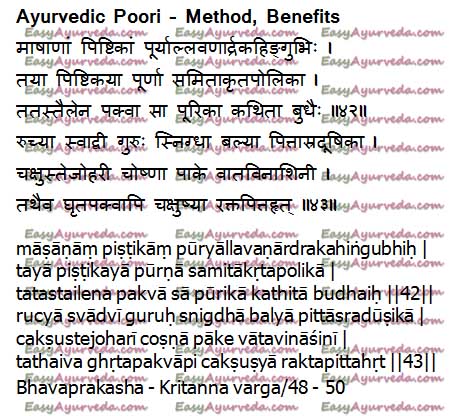How To Make Ayurvedic Poori? Detailed Method, Health Benefits
By Dr MS Krishnamurthy MD(Ayu), PhD.
The poori that we enjoy in our day to day life is mentioned in Ayurveda with full list of benefits, hundreds of years ago. Among the oil fried breakfast foods, Poori is the most popular. It is common in most parts of Karnataka, Maharashtra, Gujarath, Delhi etc. As per Ayurveda, it can be used in some health conditions and should be avoided in others.
Poori is technically an oil fried food. As per Ayurveda, fried foods usually increase Kapha Dosha and decrease Vata Dosha.
Classical reference: Bhavaprakasha – Kritanna varga/48 – 50

Table of Contents
Classical method of preparation
Classical method of Poodi making:
Black gram flour paste is prepared with water and dough is made. Mixed with salt, ginger paste and heeng (asafoetida).
The quantity of these is spices not fixed. It is decided as per one’s taste.
It is rolled into thin disc shape by pressing on an even plate. It is then fried in the sesame oil.
Qualities
Qualities of black gram poori with salt, ginger and asafoetida:
Sweet (Madhura),
heavy to digest (guru),
unctuous (snigdha),
hot in potency (ushna veerya).
Improves sexual strength, vigor
Improves immunity.
Just with black gram and salt, the Puri might be slightly difficult to digestion. Ginger and asafoetida helps in improving its ease of digestion.
Actions
Appetizer (ruchya),
nutritional/energizer (balya),
Useful in Vata disorder, neurological conditions.
As Poori (prepared out of black gram) is pacifier of vata, this can be judicially used in all Vata imbalance disorders as a dietetic substance; especially in the conditions like paraplegia, hemiplegia, facial paralysis, neuro muscular dystrophy etc it is of good choice.
Kachouri/Kachoudi (sweet mixed spicy snack well known in Gujarat and Maharashtra) has similar properties of Poodi.
Food becomes medicine, if used with rationality. Or else it may be a causative factor in the manifestation of the diseases.
Side effects
In Ayurvedic clinical practice the oily food is usually advised to avoid by the patients especially those who are suffering from skin diseases, liver disorders, gastro intestinal disorders etc.
Adding ginger and asafoetida may make the puri to increase Pitta.
So, for Pitta body type individuals, for people with eye disorders and for people with bleeding disorders, puri can be fried in ghee (clarified butter). Ghee balances both Vata and Pitta Dosha.
Modern method of preparation
Method of puri making followed nowadays:
Maida or wheat flour is used as flour.
Sunflower oil or coconut oil is used.
The choice of oil may be different but in ancient times, sesame oil was used as the main cooking oil.
Using Maida will make the Poodi more difficult to digest. This is why we feel bloated after having Poori.
Wheat flour Puri will be relatively easier to digest than the Maida Poori.









3 comments
Prasad BS
The article is either poorly drafted or edited. Some diligence should have been exercised in this regard. Disappointed as the content on this blog is usually very educative.
Dr J V Hebbar MD(Ayu)Author
Sorry for the mistake. I did not edit it well. I tried again and hope the content is better organised this time. Any suggestions of improvement is welcome. Please.
Sudharsini
Thank you for this article ! being a home maker I try to cook healthy food for my family as you have said food is the medicine . can we make powder out of the urad dhal without black covering and make this poori ?